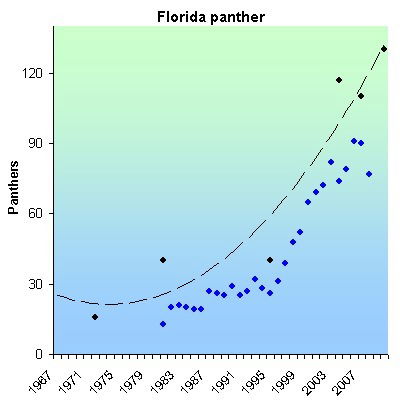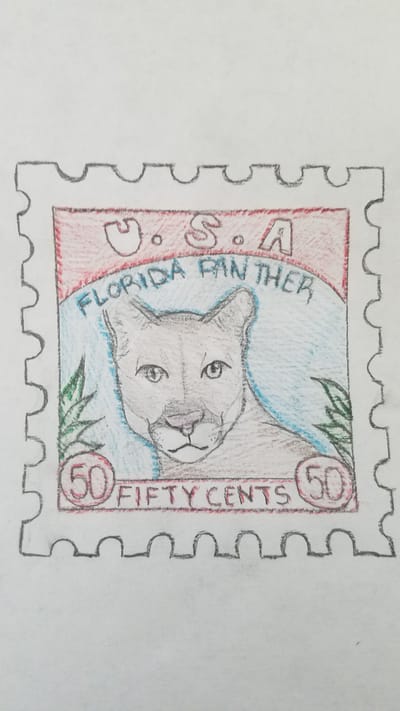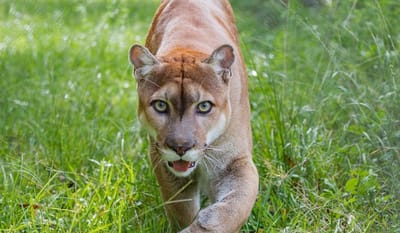SAVE THE ENDANGERED
Florida Panthers
THE SCIENCE BEHIND THE FLORIDA PANTHER
-The scientific name of the Florida Panther is Puma concolor coryi, but most commonly goes by Florida Panther. The higher classification is a cougar.
-The Florida Panther lives in both wetlands, and drylands, including cypress forests, thicket swamps, freshwater marshes, hardwood hammocks, saw palmetto woodlands, and pine flatwoods. The Florida panther likes areas with lots of cover.
-Florida Panthers are carnivores and hunt for their food, white-tailed deer are its primary food source, but also hunt down animals like, feral hogs, rabbits, raccoons, armadillos, and birds. In their South Florida habitat, Florida Panthers are the top predators, and regulate the food chain when they hunt for their food. It keeps the numbers of the prey in check and balance.
-As seen in the photo, from jacquithurlowlippisch.com, Florida Panthers have short, light brown fur and a white muzzle, chest, and stomach. It has a long tail with a slight crook in it, these features create differences compared to the mountain lion.
-The Florida Panther needs a large area to survive and has been listed as endangered since 1967, and was once down to 25 individuals. These animals are threatened from habitat loss, collisions with cars, the ill effects of inbreeding, and high levels of mercury in their prey.
-TNC is leading an effort to conserve Florida Panther habitats, by establishing connections to existing protected lands, that encompass a variety of habitat types, from native lands to working lands. The animal can also be helped by constructing highway underpasses and by helping maintain habitat connectivity for panthers.
-The Florida Panther lives in both wetlands, and drylands, including cypress forests, thicket swamps, freshwater marshes, hardwood hammocks, saw palmetto woodlands, and pine flatwoods. The Florida panther likes areas with lots of cover.
-Florida Panthers are carnivores and hunt for their food, white-tailed deer are its primary food source, but also hunt down animals like, feral hogs, rabbits, raccoons, armadillos, and birds. In their South Florida habitat, Florida Panthers are the top predators, and regulate the food chain when they hunt for their food. It keeps the numbers of the prey in check and balance.
-As seen in the photo, from jacquithurlowlippisch.com, Florida Panthers have short, light brown fur and a white muzzle, chest, and stomach. It has a long tail with a slight crook in it, these features create differences compared to the mountain lion.
-The Florida Panther needs a large area to survive and has been listed as endangered since 1967, and was once down to 25 individuals. These animals are threatened from habitat loss, collisions with cars, the ill effects of inbreeding, and high levels of mercury in their prey.
-TNC is leading an effort to conserve Florida Panther habitats, by establishing connections to existing protected lands, that encompass a variety of habitat types, from native lands to working lands. The animal can also be helped by constructing highway underpasses and by helping maintain habitat connectivity for panthers.
The history of the esa
problem/solution
Imagine, being in a world where there are only a few left of your kind, and being in risk of extinction. Today there are many people on earth, more than 7 billion, but many animals do not have anywhere near that large of a population and are listed on the endangered species list. One of these animals are the Florida Panther, an endangered wild cat in Southern Florida. They can live in both dry and wetlands including cypress forests, thicket swamps, freshwater marshes, hardwood hammocks, palmetto woodlands, and pine flatwoods. They prefer places with lots of cover. They have short light-brown fur and a white muzzle, chest, and stomach, along with a long tail with a slight crook in it. Florida panthers are predators that mainly hunt white-tailed deer, along with feral hogs, rabbits, raccoons, armadillos, and birds. Florida Panthers are being threatened through ever-increasing human population in South Florida, cars, and habitat destruction from residential and fossil fuel development which has affected their population, and can be helped through various solutions.
There are multiple problems affecting the Florida Panther population, mainly caused by humans. One of the main problems affecting Florida Panthers is habitat loss, which usually happens when human activity takes place where the species is living, for example when areas are cleared for agriculture. According to, Why We Must Protect the Florida Panther, "While oil development has taken place in discrete portions of Big Cypress, developers are targeting new areas for exploration, which will further restrict panther movements and adversely impact habitats", (Kelly, paragraph 3). This shows how human activity in Florida Panther areas is harming their population. Florida Panthers need large areas for their survival, and having it taken away is not beneficial. These human activities may also kill other animals that may be prey to the Florida Panther which would make it harder for them to find food which can also decrease the population. Even though these events are taking place, fortunately, there are solutions currently taking place.
Despite all of the negative actions being taken towards the Florida Panthers, there are also things being done to help restore the population. The Nature Conservancy (TNC) is taking action to help restore land for the Florida Panther. TNC is protecting Florida Panther land by collaborating with private land owners and purchasing property development rights. In, Help Save the Florida Panther, The TNC is trying to help conserve land for the Florida Panthers by creating connections from native lands to working lands, (Arnold, paragraph 9). This shows how TNC is working towards benefiting the growth of the Florida Panther population. These animals need plenty of land to survive, and human expansion and activity affects it negatively by clearing it out and replacing it, but people like TNC is helping provide a home to Florida Panthers for survival. Protecting land is important so it is not destroyed for different use. This is only one solution to helping protect the endangered Florida Panther, and many others can be created.
There can be different ways in how people can help improve Florida Panther populations. For example, Protect Florida Panthers, believes that another way to help increase the Florida Panther population would be to lower the speed limit in Florida Panther areas. According to, Why We Must Protect the Florida Panthers, "Last year, panther deaths tied for the worst year on record, and 34 panthers were killed by vehicle collisions alone", (Kelly, paragraph 2). This shows how Florida Panther populations also went down because of car accidents near their area. Slowing the speed limit would create less collisions which would mean less deaths of Florida Panthers by car accidents. With the population already low on the worst year record 34 Florida Panthers have been killed only by cars. If there weren't car crashes, or at least as many, it would save many lives and help the population not decrease.
In conclusion, Florida Panthers are being threatened by multiple human caused things including habitat loss, and car crashes, but can be helped through different solutions. The main problem is that the Florida Panther population dropped to being endangered from human activities. The problem of habitat loss can be fixed with the solution of protecting lands like TNC which is creating lands safe for the endangered species. The problem of car collisions, which can kill many Florida Panthers when occurring in their area can also have a solution. Creating the speed limit slower in Florida Panther areas can reduce car crashes, because it is more rare for accidents to occur in slower speed limits. As if right now the Florida Panther population is being helped and is increasing with the help of people like TNC. In conclusion, there are various problems that affect the Florida Panther population that can be solved with different solutions.
There are multiple problems affecting the Florida Panther population, mainly caused by humans. One of the main problems affecting Florida Panthers is habitat loss, which usually happens when human activity takes place where the species is living, for example when areas are cleared for agriculture. According to, Why We Must Protect the Florida Panther, "While oil development has taken place in discrete portions of Big Cypress, developers are targeting new areas for exploration, which will further restrict panther movements and adversely impact habitats", (Kelly, paragraph 3). This shows how human activity in Florida Panther areas is harming their population. Florida Panthers need large areas for their survival, and having it taken away is not beneficial. These human activities may also kill other animals that may be prey to the Florida Panther which would make it harder for them to find food which can also decrease the population. Even though these events are taking place, fortunately, there are solutions currently taking place.
Despite all of the negative actions being taken towards the Florida Panthers, there are also things being done to help restore the population. The Nature Conservancy (TNC) is taking action to help restore land for the Florida Panther. TNC is protecting Florida Panther land by collaborating with private land owners and purchasing property development rights. In, Help Save the Florida Panther, The TNC is trying to help conserve land for the Florida Panthers by creating connections from native lands to working lands, (Arnold, paragraph 9). This shows how TNC is working towards benefiting the growth of the Florida Panther population. These animals need plenty of land to survive, and human expansion and activity affects it negatively by clearing it out and replacing it, but people like TNC is helping provide a home to Florida Panthers for survival. Protecting land is important so it is not destroyed for different use. This is only one solution to helping protect the endangered Florida Panther, and many others can be created.
There can be different ways in how people can help improve Florida Panther populations. For example, Protect Florida Panthers, believes that another way to help increase the Florida Panther population would be to lower the speed limit in Florida Panther areas. According to, Why We Must Protect the Florida Panthers, "Last year, panther deaths tied for the worst year on record, and 34 panthers were killed by vehicle collisions alone", (Kelly, paragraph 2). This shows how Florida Panther populations also went down because of car accidents near their area. Slowing the speed limit would create less collisions which would mean less deaths of Florida Panthers by car accidents. With the population already low on the worst year record 34 Florida Panthers have been killed only by cars. If there weren't car crashes, or at least as many, it would save many lives and help the population not decrease.
In conclusion, Florida Panthers are being threatened by multiple human caused things including habitat loss, and car crashes, but can be helped through different solutions. The main problem is that the Florida Panther population dropped to being endangered from human activities. The problem of habitat loss can be fixed with the solution of protecting lands like TNC which is creating lands safe for the endangered species. The problem of car collisions, which can kill many Florida Panthers when occurring in their area can also have a solution. Creating the speed limit slower in Florida Panther areas can reduce car crashes, because it is more rare for accidents to occur in slower speed limits. As if right now the Florida Panther population is being helped and is increasing with the help of people like TNC. In conclusion, there are various problems that affect the Florida Panther population that can be solved with different solutions.
the florida panther population
-Since the Florida Panther went on the endangered species list, the population had a rate of change of 95% from the highest population of 500 in 1900 to the lowest of 25.
- The probability of extinction is decreasing as the population of Florida Panthers is increasing. At 1967 the population was at a low point of 25, and as time went on the population grew to about 125. This is most likely because people are helping to prevent the extinction of these animals. If this keeps up and the population keeps improving, extinction wont occur.
- Monitoring the growth of the Florida Panther population is important because it gives us information like the amounts of Florida Panthers in the wild at certain times and dates. When looking at this information we can discover when the population was at a low point and from there find out what was happening at that time that could of affected the Florida Panther population. When people are trying to help improve and increase the population they can refer to the info on graphs to see if it is working and what affect it is having. When a good affect is seen in the population, it can help shape what we do in the future, and in this case what people are doing to help on the part of the graph where there is an increase, should continue to further assist the Florida Panthers.
- The probability of extinction is decreasing as the population of Florida Panthers is increasing. At 1967 the population was at a low point of 25, and as time went on the population grew to about 125. This is most likely because people are helping to prevent the extinction of these animals. If this keeps up and the population keeps improving, extinction wont occur.
- Monitoring the growth of the Florida Panther population is important because it gives us information like the amounts of Florida Panthers in the wild at certain times and dates. When looking at this information we can discover when the population was at a low point and from there find out what was happening at that time that could of affected the Florida Panther population. When people are trying to help improve and increase the population they can refer to the info on graphs to see if it is working and what affect it is having. When a good affect is seen in the population, it can help shape what we do in the future, and in this case what people are doing to help on the part of the graph where there is an increase, should continue to further assist the Florida Panthers.

Florida Panther Postage stamp

florida panther region (southeast) music
Florida panther natural hunting performance, decline pushup excersize
-The second picture shows the stance of the Florida Panther when crouching down to make sure the prey doesn't see it coming, this is what Florida Panthers do when hunting.
- After crouching they quickly pounce and catch their prey which would be going back to the first position of the exercise.
work cited
Richardson, Larry. Florida Panther. Fsw.gov. 11 January 2018. Web. 13 April 2020.
Roberts, Carter. The US Endangered Species Act. Worldwildlife.org. 13 June 2019. Web. 14 April 2020.
Kelly, Alison. Why We Must Protect the Florida Panther. Nrdc.org. 20 September 2017. Web. 21 April 2020.
Arnold, Keith. Help Save the Florida Panther. Nature.org. 5 August 2019. Web. 14 April 2020.
Make A Donation
Donate to help the Florida Panthers.

$25
Join us
- Tampa, Florida, United States
